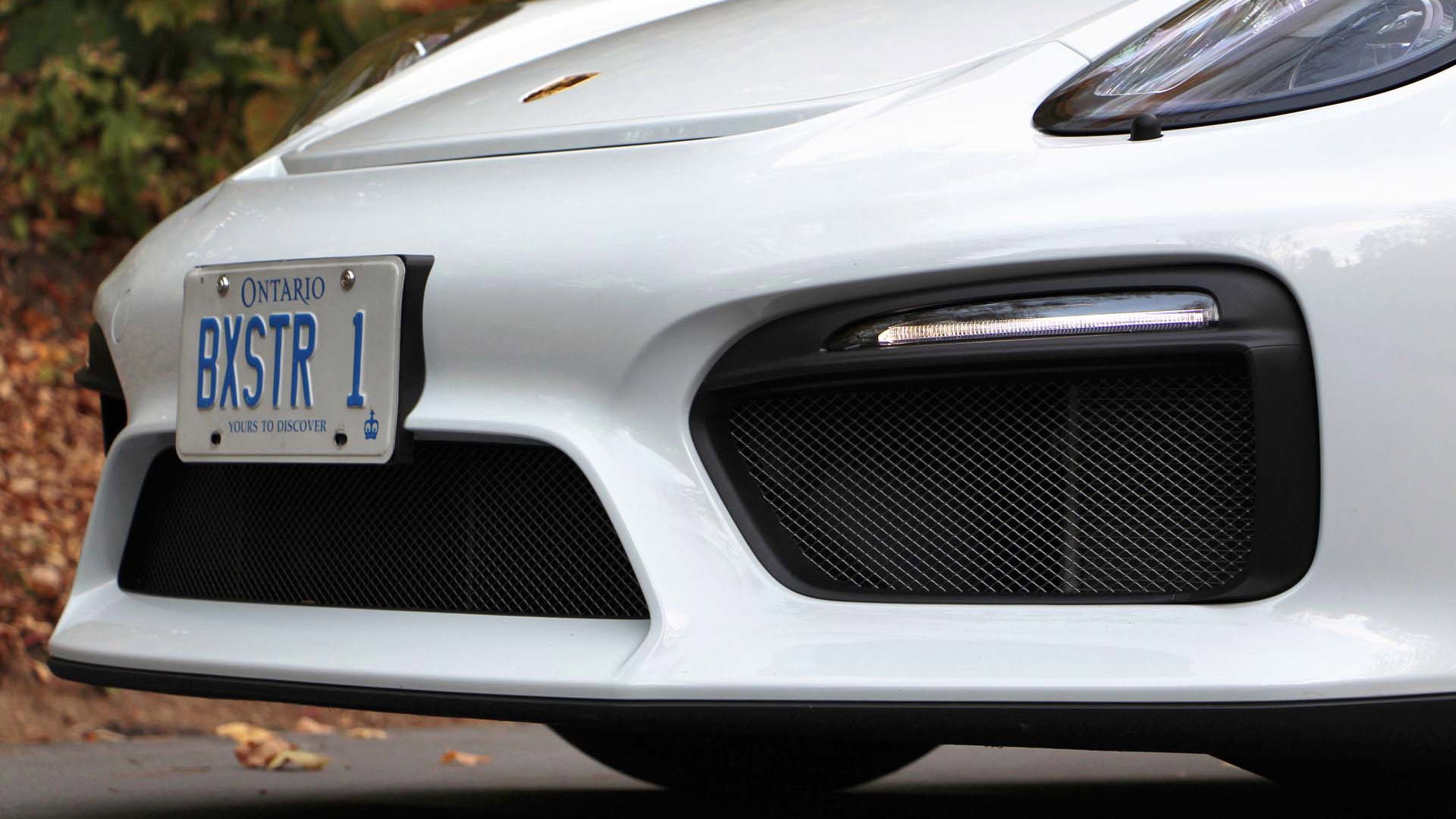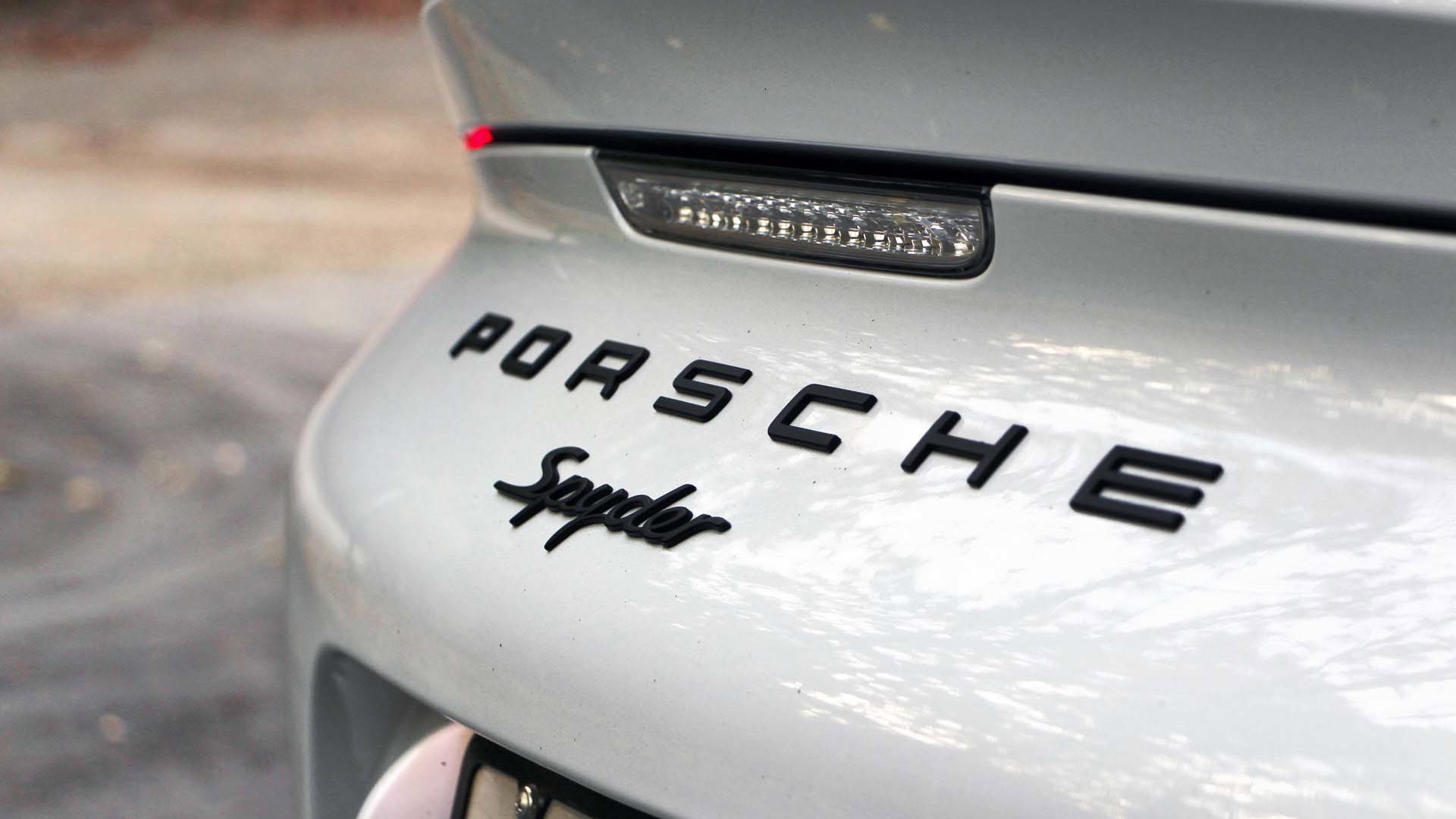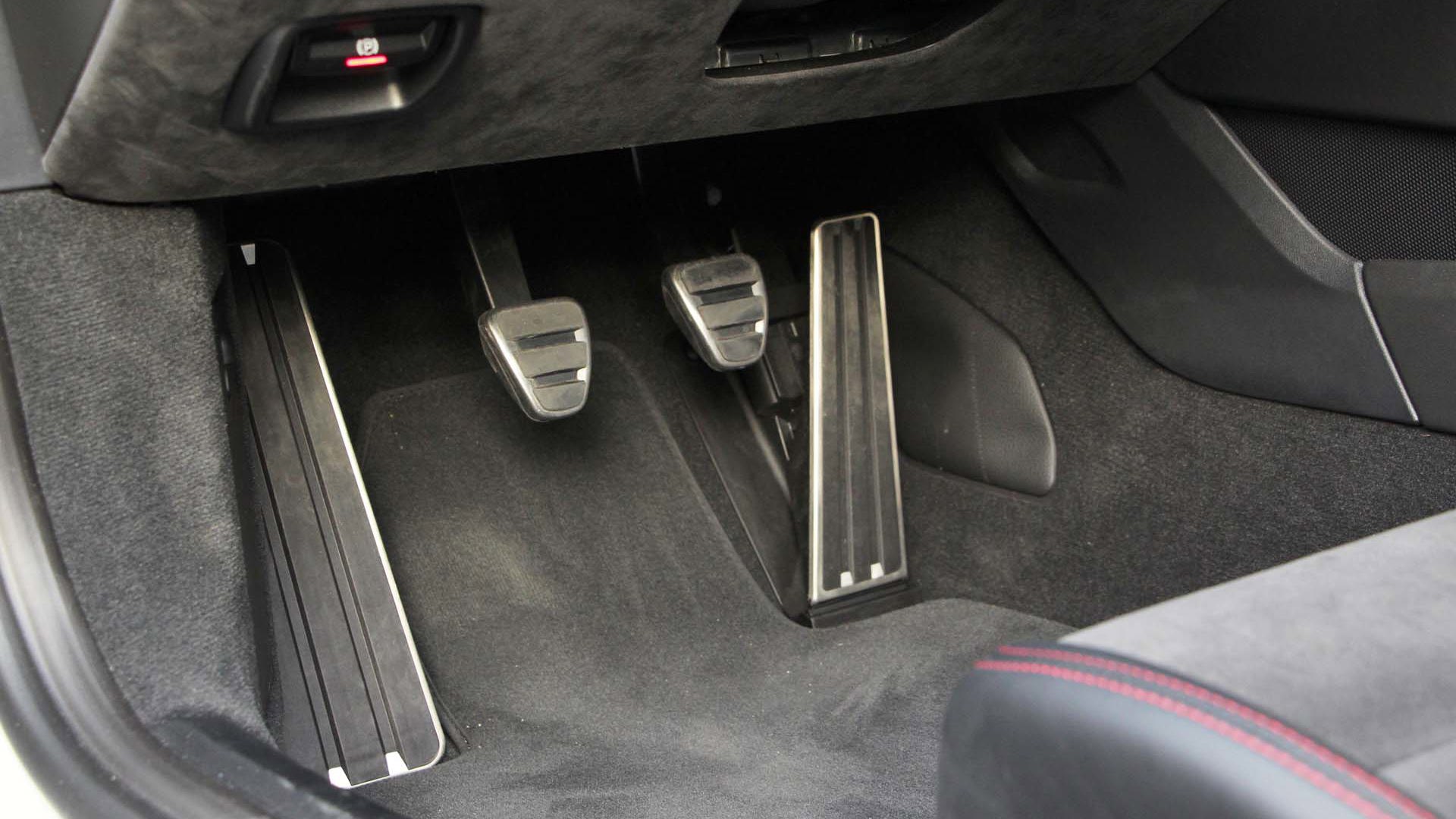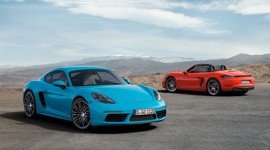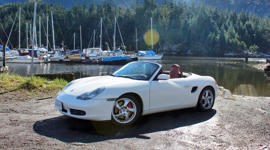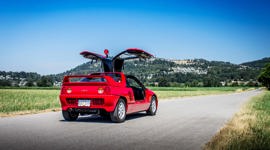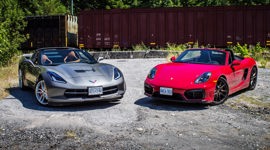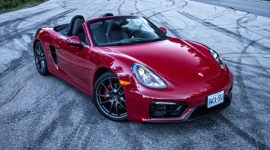 AutoTrader SCORE
AutoTrader SCORE
-
EXTERIOR STYLING10/10
-
INTERIOR10/10
-
COMFORT10/10
-
FUEL ECONOMY10/10
-
PERFORMANCE10/10
The 2016 Porsche Boxster Spyder is a time machine. Not literally, of course, because those don’t really exist (in this dimension).
The Spyder is a curious amalgamation of various generations of Porsche greatness.
No, the Spyder is a curious amalgamation of various generations of Porsche greatness. The very name Spyder takes us back to the fifties and sixties, when the moniker was appended to numbers such as 550 and 718, and could be found running at playgrounds like Sebring, Targa Florio, and other legendary venues. The Boxster is a child of the nineties, and the original platform soldiered on with relatively few systemic changes until the arrival of the third generation in 2012 bearing the 981 platform code, this time receiving a thoroughly reworked platform fitting for a 21st century sports car. Not a roadster, a sports car. But it’s a roadster too. And very good at both functions, I must add.
On racing circuits, a mid-engine layout is common enough, but only a handful of cars available for sale to the public in this day and age feature such a dedicated performance layout. The Boxster, I dare say, is the greatest, taking into consideration value.
In Canada, the Boxster starts for as little $60K, the cheapest car in Porsche’s lineup, and only a few hundred more than a base Macan and a few hundred less than the starting point for Cayman. That price, is, in fact, a very large part of its greatness. While not as affordable as Corollas or CR-Vs, or even sports cars like the Toyobaru twins or the MX-5, it’s not astronomical as so many of the performance sedans, muscle cars and supercars that fill the interwebs with our lust and desire. While it can take another good $10-20K before the Boxster is a performance powerhouse, and the best-of-breed Spyder starts at $93,700, the example you see here cresting $100K, its elemental goodness is part and parcel of even that most basic Boxster (or Cayman for that matter). My point: the value is there, but if you have the credit, you can improve it to your heart’s desire.
From a distance, you might not look at it and think that this is a $100K car. There’s no flashy colour scheme, just stormtrooper-scheme black accents on a pristine white background. Look closer, or spot the aerodynamic buttresses on the rear deck, calling to mind the 918 Spyder’s hunched stance, and it begins to seem a little more exotic. While unassuming, this car drew a lot of looks with its dramatic contrast, big black air intakes and accents and stunningly perfect proportions. Okay, if you stare at the profile for too long, the large wheels seem to grow even larger, but it’s appropriate given that this car feels like it is all wheels, like you are simply strapped, tightened on a rack, to a set of four sticky, grippy tires.
This, or the 911? 2017 Porsche 911 First Drive
Every bit of tension between those four corners vibrates through the chassis like the harmony of the spheres providing a sense of oneness with the universe, but with cupholders. Vestigial cupholders, but hey, it still has cupholders. Okay, they’re not so bad, but anything over a Timmy’s Medium or Starbucks Tall is riding in a precarious perch that promises instant wardrobe malfunction at the first exploration of this car’s capabilities, and those capabilities are prodigious. Moral of the story: Make friends with espresso.
So, the mid-engine layout is rare on street cars but beloved in racing and any kind of driving, really, for concentrating the vehicle’s mass in its longitudinal centre. Vertically, the horizontal ‘boxer’ layout of the Boxster’s six cylinders means the engine can be mounted lower than your typical inline or vee configuration. We like lower engines because they are usually the heaviest part, and lowering weight also improves the car’s balance. And in general, the less weight the better, because less weight makes the entire car easier to accelerate, stop and change directions. The Spyder’s singular purpose in the Boxster lineup is to achieve the very best of all those attributes: lowered by 20 mm, lightened by over 30 kg (1,315 kg) along with an increase in power to make it go faster.
And this time around, it’s a big increase in power: 60 more hp than the S, 45 more than the GTS. Rather than tweaking the 3.4L H6 in use elsewhere in the Boxster lineup, Porsche retrofitted the 911 Carrera S 3.8L flat-six for the Spyder and Cayman GT4, here tuned to 375 hp at 6,700 rpm, while the Cayman GT4 gets a bonus 10 hp at a clinically manic 7,400.
While the concept of a lightweight, elemental roadster is a throwback, this engine is thoroughly of the modern era, achieving its power along with the proscribed efficiency via direct injection, dual overhead cams with variable valve timing, dry-sump lubrication, water-cooled with aluminum block and cylinder heads. The suspension is modern, too, but ditches the electronically adjustable shocks in favour of well-sorted sport suspension that gives it that 20-mm drop in ride height, and then there are the myriad electronic safety systems like stability control and torque vectoring which in Porsche’s hands border on arcane black magic, though they can be regressed to more primitive levels governed by the Sport Chrono Package’s varying degrees of independence and aggression for the driver.
Those are the numbers, but the experience is classic and timeless to go along with its natural aspiration, perhaps the last of its kind in Porsches. Offered only with a six-speed manual transmission, there is no hesitation from computer controlled clutches, just the feel of the clutches biting and power coursing to the rear wheels (that’s right, it’s also only rear-wheel drive – a purist’s dream everywhere you turn). The power rises in an equally traditional linear surge, enough torque at moderate revs to chirp tires or downright smoke ‘em, but its peak 310 lb-ft are attained at a reasonable 4,750 rpm, making launches and control at every speed eminently controllable.
And it makes noises, too. There is a button to amplify the exhaust in all its unfettered cacophony. Press it, or keep the car in Sport mode, which also goes to full exhaust mode. Cars like this, the F-Type and Corvette should be heard in all their glory, all the time. Then again, it is also nice to drive them all the time, so the whole roof thing in winter would quite nice. We hate you Arizona.
As you grip the smaller-diameter, gloriously buttonless steering wheel (ours was covered in Alcantara no less – an orgasm for your hands at every touch) and the short shifter and unleash this meanest of Boxsters, the engine sitting just behind your seat wails its explosive binge-burning of hydrocarbons and the exhaust keens its signature Porsche metallic rasp, then cackles delicious staccato bursts as you lift off the throttle, blatting away at downshifts and generally making sweet audible mayhem, the exposed feast of sound a far greater boon than something like mere protection from the elements. There are more noises too, and they are many and wonderful.
And we haven’t even gotten to the drive. I’m almost loathe to share for fear that the memories will fade as the words creep out on the page. Quite simply, it is the best car I’ve ever driven. While older cars may have greater feedback in their hydraulic or manual steering racks, I’d trade that any day for the precision, weight, speed and feel of the Spyder paired with this sublime platform. The steering is sharp and immediate, quickened over the standard Boxsters, seemingly without a millimetre of wasted motion.
The gearbox and clutch are an ideal pairing as well, quick, clear takeup from the pedal and short, snickety throws from the stick make it both easy and rewarding to extract performance without being frustrating in traffic. It has been noted that the gearing is fairly tall, no doubt to achieve some measure of efficiency, but the power band is fairly wide so that most tighter corners can be handled in second and the rest in third. Depending on track configuration you might have some gaps in power by staying in gears longer, but on the twisting roads I drove it was of little concern except on one hairpin followed by a steeper climb that required first gear.
Although the Cayman GT4 is the more hardcore of the top-spec 981 twins, benefiting from those extra 10 hp and the 911 GT3’s front suspension and a big fixed spoiler that clearly ‘means business’, it is the Spyder that captures driving magic without looking like a boy racer but rather a Concours special, and promises a more well-rounded experience, its ride mysteriously comfortable despite such unwavering stance in corners. This thing does not understand the meaning of body roll, and it would take a track to tease out any pitch during hard braking, so it is under control at all times, with the pedals and seat relaying any shifts in weight transfer flawlessly and the steering wheel capturing any wavering of the tires grip for superpower-like confidence.
Before parting, we must complain about some of the loss of purity over the previous generation. The 2011 Boxster Spyder weighed in at an even more extreme 1,275, shaving 80 kg from the Boxster S of its generation. A large portion of that less extreme weight loss is the roof. This generation’s roof is far more substantial and easier to operate, with reinforced panels to help keep its shape rather than pure fabric stretched taut, with an agonizingly convoluted process to remove, fold and stow, and equally irritating process to put in place should you encounter surprise weather other than sunshine. But with that car, you could also simply leave the roof in the garage if you are certain of the forecast.
The new roof is fixed to the car via hoops and folding arms. Some have complained that the hidden buttons to release the corner panels are difficult. Wow, like, seriously? While not as easy as the new Miata (is anything that easy), it’s a 30-second job which required walking around the car to fold and stow or raise and attach certain bits. Not a deal breaker.
Nothing about this car should be a deal breaker, except its price and practicality (if you cannot afford a seasonal toy for $100K). You could drive it in winter, but please don’t. One hundred years from now, this will be on the Pebble Beach Concours as one of the last great analogue Porsches. I know that, because it’s a time machine.
Quick Facts: 2016 Porsche Boxster Spyder
Layout: Mid-engine, rear-drive
Engine: naturally aspirated 3.8L flat-six
Transmission: six-speed manual only
Power: 375 hp at 6,700 rpm
Torque: 310 lb-ft at 4,750 rpm
Redline: 7,800 rpm
Weight: 1,315 kg
Front Brakes: six-piston calipers, 330-mm vented rotors
Rear Brakes: four-piston calipers, 299-mm vented rotors
Tires: P235/35ZR20 front, P265/35ZR20 rear
Acceleration: 0-100 km/h in 4.5 seconds (Boxster GTS: 4.9 seconds)
| Warranty: 4 years/80,000 km; 4 years/80,000 km powertrain; 12 years/unlimited distance corrosion perforation; 4 years/80,000 km roadside assistance Competitors: |
| Model Tested | 2016 Porsche Boxster Spyder |
|---|---|
| Base Price | $93,700 |
| A/C Tax | |
| Destination Fee | $1,085 |
| Price as Tested | $100,055 |
|
Optional Equipment
Carrara White Metallic paint $820, Leather with Alcantara $2,470, Bi-Xenon headlights w/ Dynamic Light System $790, contrast stitching $1,190
|
|










